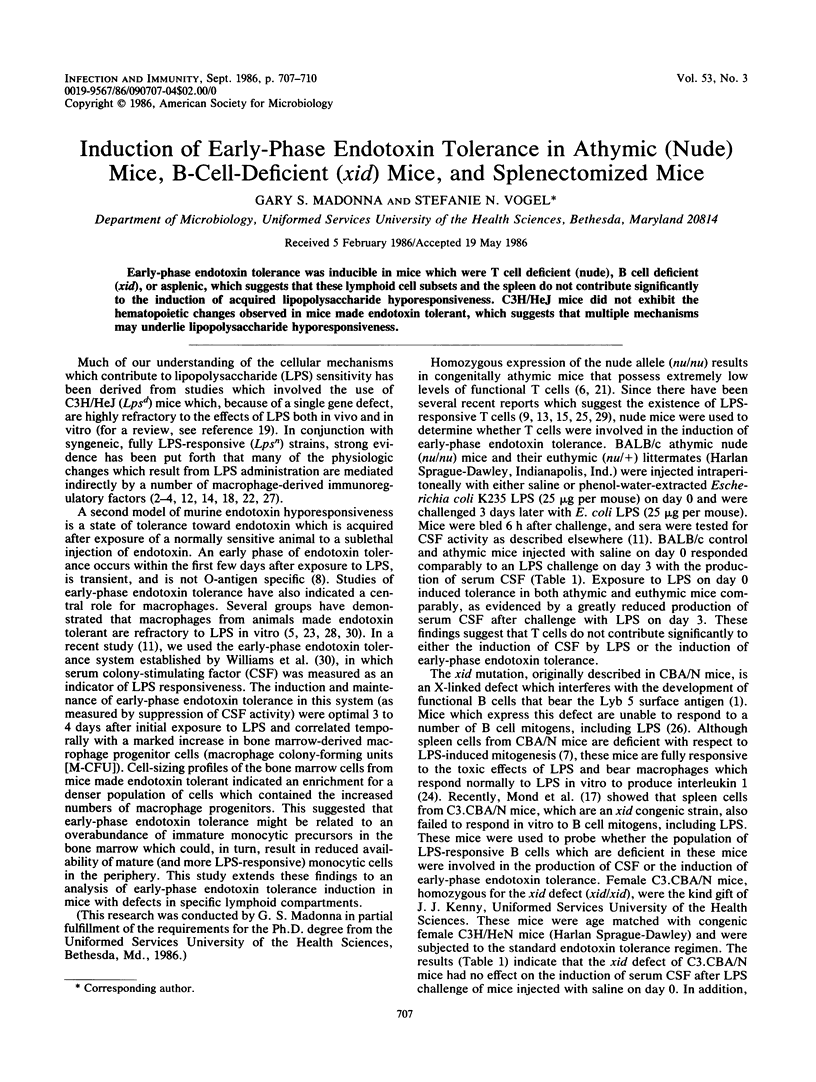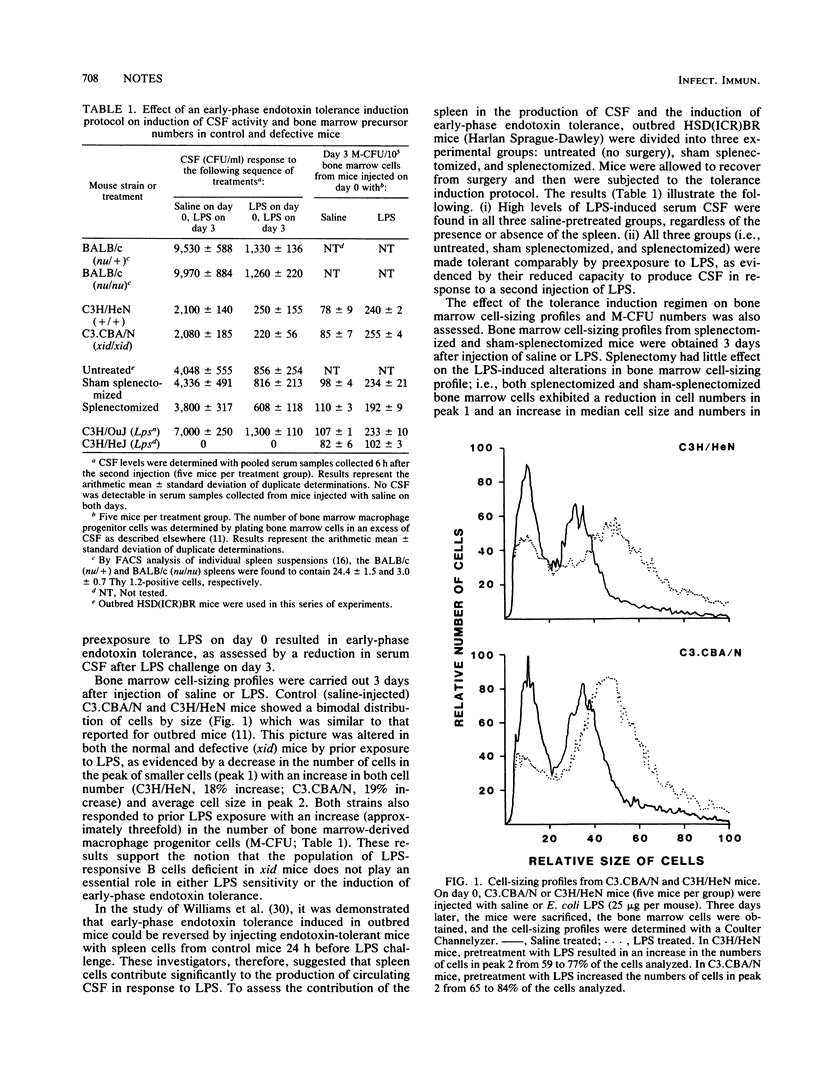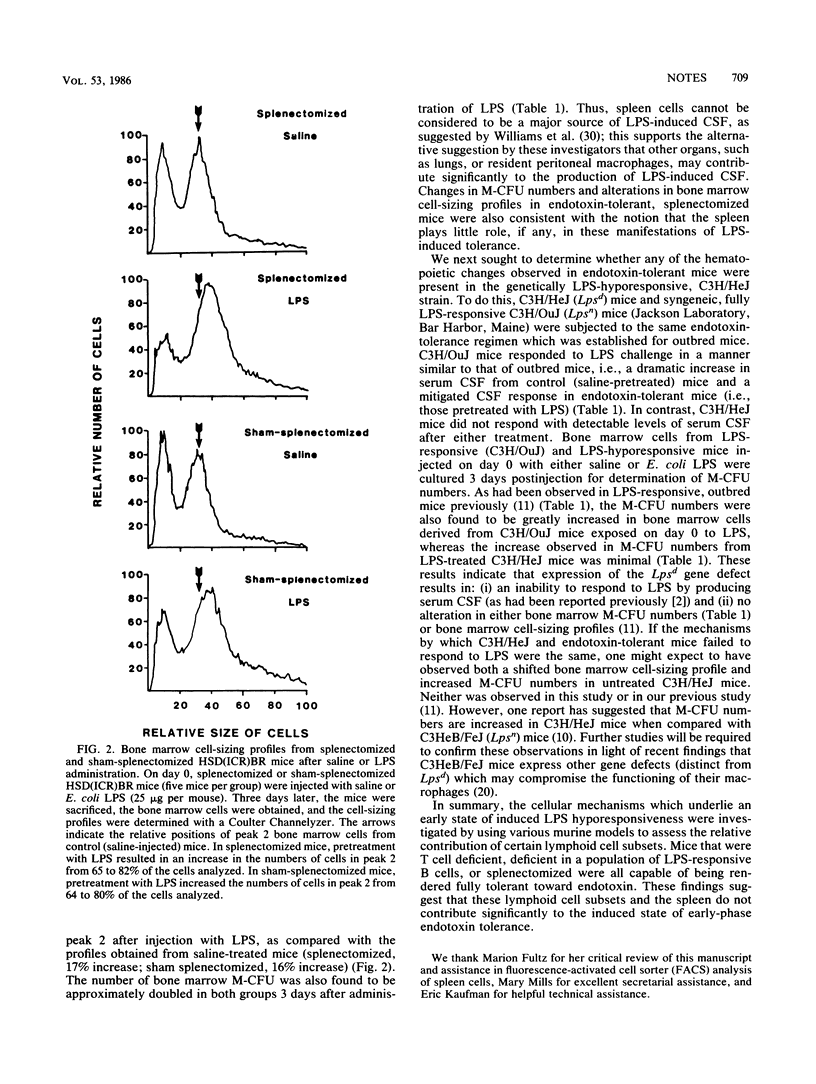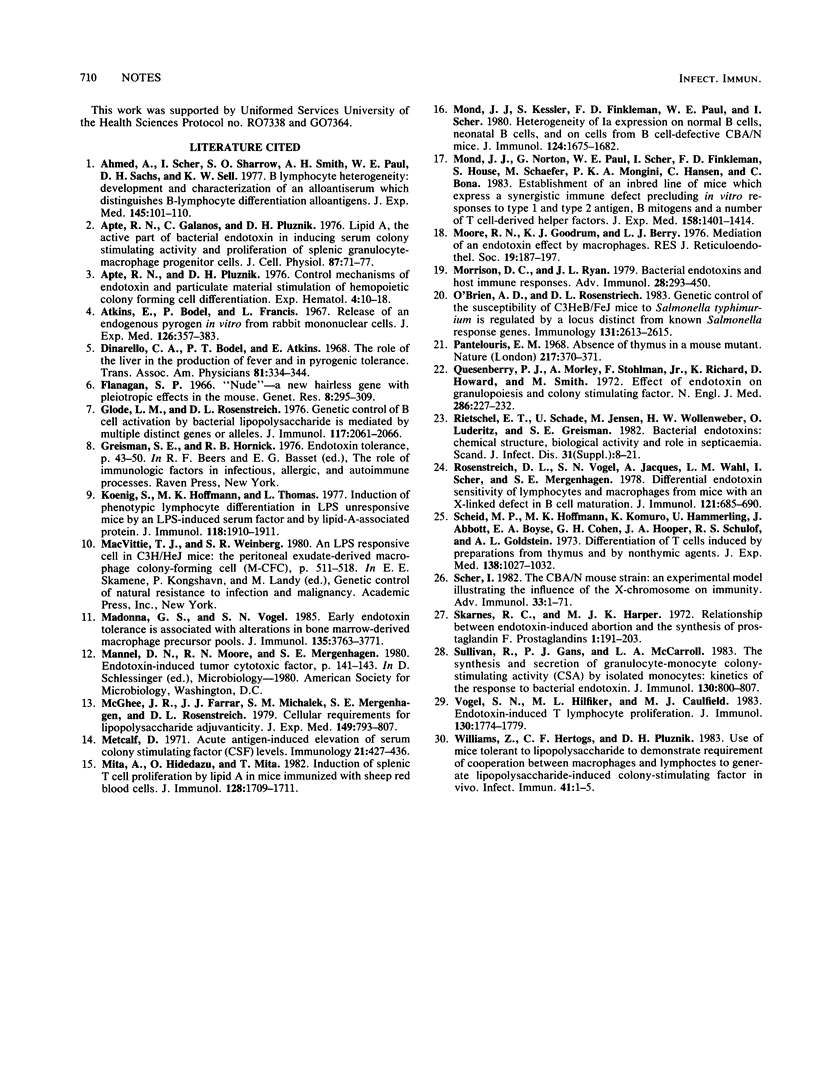Abstract
Early-phase endotoxin tolerance was inducible in mice which were T cell deficient (nude), B cell deficient (xid), or asplenic, which suggests that these lymphoid cell subsets and the spleen do not contribute significantly to the induction of acquired lipopolysaccharide hyporesponsiveness. C3H/HeJ mice did not exhibit the hematopoietic changes observed in mice made endotoxin tolerant, which suggests that multiple mechanisms may underlie lipopolysaccharide hyporesponsiveness.
Full text
PDF



Selected References
These references are in PubMed. This may not be the complete list of references from this article.
- Ahmed A., Scher I., Sharrow S. O., Smith A. H., Paul W. E., Sachs D. H., Sell K. W. B-lymphocyte heterogeneity: development and characterization of an alloantiserum which distinguishes B-lymphocyte differentiation alloantigens. J Exp Med. 1977 Jan 1;145(1):101–110. doi: 10.1084/jem.145.1.101. [DOI] [PMC free article] [PubMed] [Google Scholar]
- Apte R. N., Galanos C., Pluznik D. H. Lipid A, the active part of bacterial endotoxins in inducing serum colony stimulating activity and proliferation of splenic granulocyte/macrophage progenitor cells. J Cell Physiol. 1976 Jan;87(1):71–78. doi: 10.1002/jcp.1040870110. [DOI] [PubMed] [Google Scholar]
- Apte R. N., Pluznik D. H. Control mechanisms of endotoxin and particulate material stimulation of hemopoietic colony forming cell differentiation. Exp Hematol. 1976 Jan;4(1):10–18. [PubMed] [Google Scholar]
- Atkins E., Bodel P., Francis L. Release of an endogenous pyrogen in vitro from rabbit mononuclear cells. J Exp Med. 1967 Aug 1;126(2):357–384. doi: 10.1084/jem.126.2.357. [DOI] [PMC free article] [PubMed] [Google Scholar]
- Dinarello C. A., Bodel P. T., Atkins E. The role of the liver in the production of fever and in pyrogenic tolerance. Trans Assoc Am Physicians. 1968;81:334–344. [PubMed] [Google Scholar]
- Flanagan S. P. 'Nude', a new hairless gene with pleiotropic effects in the mouse. Genet Res. 1966 Dec;8(3):295–309. doi: 10.1017/s0016672300010168. [DOI] [PubMed] [Google Scholar]
- Glode L. M., Rosenstreich D. L. Genetic control of B cell activation by bacterial lipopolysaccharide is mediated by multiple distinct genes or alleles. J Immunol. 1976 Dec;117(6):2061–2066. [PubMed] [Google Scholar]
- Koenig S., Hoffmann M. K., Thomas L. Induction of phenotypic lymphocyte differentiation in LPS unresponsive mice by an LPS-induced serum factor and by lipid A-associated protein. J Immunol. 1977 May;118(5):1910–1911. [PubMed] [Google Scholar]
- Madonna G. S., Vogel S. N. Early endotoxin tolerance is associated with alterations in bone marrow-derived macrophage precursor pools. J Immunol. 1985 Dec;135(6):3763–3771. [PubMed] [Google Scholar]
- McGhee J. R., Farrar J. J., Michalek S. M., Mergenhagen S. E., Rosenstreich D. L. Cellular requirements for lipopolysaccharide adjuvanticity. A role for both T lymphocytes and macrophages for in vitro responses to particulate antigens. J Exp Med. 1979 Apr 1;149(4):793–807. doi: 10.1084/jem.149.4.793. [DOI] [PMC free article] [PubMed] [Google Scholar]
- Metcalf D. Acute antigen-induced elevation of serum colony stimulating factor (CFS) levels. Immunology. 1971 Sep;21(3):427–436. [PMC free article] [PubMed] [Google Scholar]
- Mita A., Ohta H., Mita T. Induction of splenic T cell proliferation by lipid A in mice immunized with sheep red blood cells. J Immunol. 1982 Apr;128(4):1709–1711. [PubMed] [Google Scholar]
- Mond J. J., Kessler S., Finkelman F. D., Paul W. E., Scher I. Heterogeneity of Ia expression on normal B cells, neonatal B cells, and on cells from B cell-defective CBA/N mice. J Immunol. 1980 Apr;124(4):1675–1682. [PubMed] [Google Scholar]
- Mond J. J., Norton G., Paul W. E., Scher I., Finkelman F. D., House S., Schaefer M., Mongini P. K., Hansen C., Bona C. Establishment of an inbred line of mice that express a synergistic immune defect precluding in vitro responses to type 1 and type 2 antigens, B cell mitogens, and a number of T cell-derived helper factors. J Exp Med. 1983 Nov 1;158(5):1401–1414. doi: 10.1084/jem.158.5.1401. [DOI] [PMC free article] [PubMed] [Google Scholar]
- Moore R. N., Goodrum K. J., Berry L. J. Mediation of an endotoxic effect by macrophages. J Reticuloendothel Soc. 1976 Mar;19(3):187–197. [PubMed] [Google Scholar]
- Morrison D. C., Ryan J. L. Bacterial endotoxins and host immune responses. Adv Immunol. 1979;28:293–450. doi: 10.1016/s0065-2776(08)60802-0. [DOI] [PubMed] [Google Scholar]
- O'Brien A. D., Rosenstreich D. L. Genetic control of the susceptibility of C3HeB/FeJ mice to Salmonella typhimurium is regulated by a locus distinct from known salmonella response genes. J Immunol. 1983 Dec;131(6):2613–2615. [PubMed] [Google Scholar]
- Pantelouris E. M. Absence of thymus in a mouse mutant. Nature. 1968 Jan 27;217(5126):370–371. doi: 10.1038/217370a0. [DOI] [PubMed] [Google Scholar]
- Quesenberry P., Morley A., Stohlman F., Jr, Rickard K., Howard D., Smith M. Effect of endotoxin on granulopoiesis and colony-stimulating factor. N Engl J Med. 1972 Feb 3;286(5):227–232. doi: 10.1056/NEJM197202032860502. [DOI] [PubMed] [Google Scholar]
- Rietschel E. T., Schade U., Jensen M., Wollenweber H. W., Lüderitz O., Greisman S. G. Bacterial endotoxins: chemical structure, biological activity and role in septicaemia. Scand J Infect Dis Suppl. 1982;31:8–21. [PubMed] [Google Scholar]
- Rosenstreich D. L., Vogel S. N., Jacques A., Wahl L. M., Scher I., Mergenhagen S. E. Differential endotoxin sensitivity of lymphocytes and macrophages from mice with an X-linked defect in B cell maturation. J Immunol. 1978 Aug;121(2):685–690. [PubMed] [Google Scholar]
- Scheid M. P., Hoffmann M. K., Komuro K., Hämmerling U., Abbott J., Boyse E. A., Cohen G. H., Hooper J. A., Schulof R. S., Goldstein A. L. Differentiation of T cells induced by preparations from thymus and by nonthymic agents. J Exp Med. 1973 Oct 1;138(4):1027–1032. doi: 10.1084/jem.138.4.1027. [DOI] [PMC free article] [PubMed] [Google Scholar]
- Scher I. The CBA/N mouse strain: an experimental model illustrating the influence of the X-chromosome on immunity. Adv Immunol. 1982;33:1–71. doi: 10.1016/s0065-2776(08)60834-2. [DOI] [PubMed] [Google Scholar]
- Skarnes R. C., Harper M. J. Relationship between endotoxin-induced abortion and the synthesis of prostaglandin F. Prostaglandins. 1972 Mar;1(3):191–203. doi: 10.1016/0090-6980(72)90004-4. [DOI] [PubMed] [Google Scholar]
- Sullivan R., Gans P. J., McCarroll L. A. The synthesis and secretion of granulocyte-monocyte colony-stimulating activity (CSA) by isolated human monocytes: kinetics of the response to bacterial endotoxin. J Immunol. 1983 Feb;130(2):800–807. [PubMed] [Google Scholar]
- Vogel S. N., Hilfiker M. L., Caulfield M. J. Endotoxin-induced T lymphocyte proliferation. J Immunol. 1983 Apr;130(4):1774–1779. [PubMed] [Google Scholar]
- Williams Z., Hertogs C. F., Pluznik D. H. Use of mice tolerant to lipopolysaccharide to demonstrate requirement of cooperation between macrophages and lymphocytes to generate lipopolysaccharide-induced colony-stimulating factor in vivo. Infect Immun. 1983 Jul;41(1):1–5. doi: 10.1128/iai.41.1.1-5.1983. [DOI] [PMC free article] [PubMed] [Google Scholar]


